|
|
From Wild Horse to the Nokota Breed:
One Herd's Fight for Survival

Text and Photographs by Castle
McLaughlin
One of the few North American wild horse herds
remaining on National Park Service (NPS) lands in the United States are in
Theodore Roosevelt National Park (THRO), located in southwestern North Dakota.
Because of it's administration by the NPS, the
herd is relatively little known.
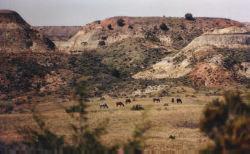 |
Unlike other U.S. federal
agencies, the National Park Service (NPS) is exempt from the Wild and Free
Roaming Horse and Burro Act and associated regulations, and officially regards
wild horses as undesireable "exotics." As at Assateague Island
National Seashore, the NPS has permitted horses to remain in the North Dakota
park (THRO) because of their historic presence in the area and due to strong
local support for their preservation. |
| Between 1880 and
1950, bands of wild horses were scattered throughout the rugged Little Missouri
Badlands, which arc across the western half of North Dakota and are partially
encompassed by two units of THRO. As elsewhere in the U.S., most wild horses in
North Dakota were eradicated by federal and state agencies by 1940.
|
 |
When Theodore Roosevelt National Park was created
near Medora, North Dakota, and then fenced ca. 1950, a few remnant harem bands
were inadvertantly enclosed into the nearly 50,000 acre south unit of the park.
For the next twenty years, the NPS tried to remove or destroy the horses. Many
removal efforts were protested and thwarted by members of the local community,
who regarded the horses as an integral aspect of regional culture and history.
 |
By 1970, THRO began to
re-evaluate the removal policy. Public pressure, including both the sentiments
of area residents and the growing national climate of support for the
preservation of wild horses, was an important factor. Additionally, park
managers became aware of historical data documenting the presence of wild
horses during the open range ranching era, which the park was established to
commemorate.
|
U.S. President Theodore Roosevelt, for whom the
park was named, lived and ranched in the Medora area between 1883-1886.
Describing wild horses in the badlands, Roosevelt wrote they were "quite
as wild as the antelope on whose domain they have intruded." Badlands
ranchers continued to chase and round-up wild horses in the badlands until the
park was established.
| Although the park has now accepted the
horses, their management during the past thirty years has been controversial.
Since as an agency the NPS regards wild equines as undesireable, there is no
overall wild horse policy. Individual parks that have accepted wild horses make
local management decisions. At THRO, the horses are classified as "feral
livestock" and are managed as an "historical demonstration
herd." Unlike other federal agencies that administer wild horse herds, the
park chose not to manage for an historically accurate herd. |
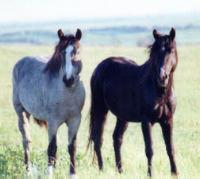 |
Throughout the 1950s and 1960s, the park
repudiated several individuals who claimed that the horses might be Spanish
Mustangs and should be protected. In the 1980s, the THRO superintendent decided
to change the phenotype of the park horses, which looked like nineteenth
century Indian ponies and were predominantly roan, overo, black and grey.
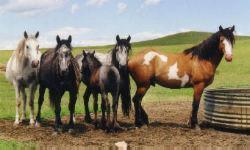 |
The dominant stallions were
removed and replaced with domestic animals in order to create horses with a
more modern phenotype. Most horses in the park today are the descendants of
introduced stallions, which included Quarter Horses, an Arabian, and a
part-Shire bucking horse. |
Round-ups are staged every few years and
"excess" animals are sold at public auction. Current management goals
are to maintain a population of less than 140 animals. Since the NPS is exempt
from federal laws protecting wild horses, there are no regulations governing
the conduct of round-ups, and no restrictions on resulting sales. In the past,
most captured horses have been sold for slaughter. The next round-up is
scheduled for the fall of 2000.
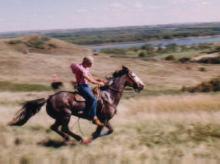 |
The original badlands horses
would have disappeared if not for the efforts of two brothers from Linton,
North Dakota. Leo Kuntz, Jr. and Frank Kuntz began buying a few individual
horses from park sales in the late 1970s. After those horses proved themselves
in cross-country races and their "old-fashioned" appearance drew
comments from other horsemen, the brothers began investigating the history of
the park horses. |
They discovered that the Marquis De Mores, a
French entrepreneur who founded the town of Medora, North Dakota, had purchased
horses confiscated from Sitting Bull's band at Fort Buford. The Marquis
range-bred the horses on land now enclosed by THRO before selling a group of
mares to the large HT ranch, located some twenty miles to the southeast. The HT
range-bred the mares to Throughbred stallions, and the resulting cross-bred
horses excelled at ranch work, polo, and racing.
| Photographs of the Sioux mares
owned by de Mores and the HT bear a striking resemblance to some of the horses
that were in the park through the 1980s, and the Kuntz brothers believe that
the Sitting Bull stock influenced the badlands herds. Other ranch horses used
in the area between 1880-1940 and which may have impacted the wild herds were
also of the "Indian pony," Spanish, and early Quarter Horse
type. |
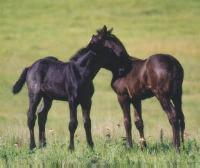 |
During the mid-1980s, the Kuntz brothers began
buying as many park horses as they could, in order to save them from slaughter.
They have since devoted their lives to maintaining the horses on their family
farm outside of Linton, while strenously but unsuccessfully lobbying the NPS to
reinstate the "old lines" into the park. They have also named the
once-wild animals "Nokota horses," and have started a breed registry.
In recognition of the role that early ranch and Indian horses played in state
history, North Dakota legislators passed a bill in 1988 declaring the Nokota
the "honorary state equine." With advice from Dr. Phillip Sponenberg,
an expert on colonial Spanish horses, Leo Kuntz Jr. has been selectively
breeding to maintain the Spanish and Indian horse phenotype. The horses are
allowed as much freedom as possible, in order to maintain their natural
behavior and organization.
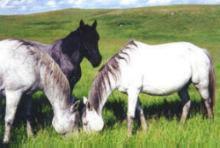 |
In 1999, the Kuntz family and
their supporters founded the Nokota Horse Conservancy, Inc., which was recently
granted non-profit status. The primary goal of the conservancy is to acquire
land for a sanctuary. Should they succeed, the horses will have found refuge
after more than a century of persecution. |
|


